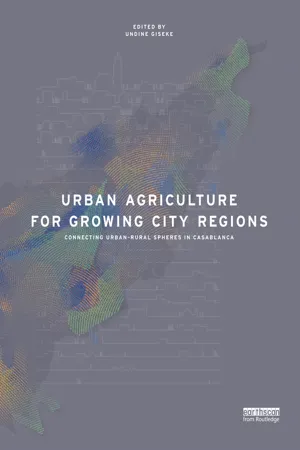
Urban Agriculture for Growing City Regions
Connecting Urban-Rural Spheres in Casablanca
- 570 pages
- English
- ePUB (mobile friendly)
- Available on iOS & Android
Urban Agriculture for Growing City Regions
Connecting Urban-Rural Spheres in Casablanca
About This Book
This book demonstrates how agriculture can play a determining role in integrated, climate-optimised urban development. Agriculture within urban growth centres today is more than an economic or social left-over or a niche practice. It is instead a complex system that offers multiple potentials for interaction with the urban system. Urban open space and agriculture can be linked to a productive green infrastructure – this forms new urban-rural linkages in the urbanizing region and helps shape the city. But in order to do this, agriculture has to be seen as an integral part of the urban fabric and it has to be put on the local agenda.
Urban Agriculture for Growing City Regions takes the example of Casablanca, one of the fastest growing cities in North Africa, to investigate this approach. The creation of synergies between the urban and rural in an emerging megacity is demonstrated through pilot projects, design solutions, and multifunctional modules. These synergies assure greater resource efficiency; particularly regarding the use and reuse of water, and they strengthen regional food security and the social integration of multiple spheres. A transdisciplinary research approach brings together different scientific disciplines and local actors into a process of integrated knowledge production. The book will have a long lasting legacy and is essential reading for researchers, planners, practitioners and policy makers who are working on urban development and urban agricultural strategies.
Frequently asked questions
Information
H
| ENDNOTES |
| REFERENCES |
| LIST OF FIGURES |
| LIST OF TABLES |
| LIST OF ABBREVIATIONS |
| INDEX |
Endnotes
Preface
A
A1
A2
Table of contents
- Cover Page
- Half Title page
- Dedication
- Title Page
- Copyright Page
- Preface
- Acknowledgements
- List of Contributors
- Contents
- A Why are we Talking About Agriculture as Part of the City? - Framing a Problem from Life-World to Research
- B The Context: Grand Casablanca
- C Understanding the Problems of Grand Casablanca
- D On the Way to Target Knowledge: Scenarios and Action Research
- E Deepening Target Knowledge Towards Problem Solving
- F Changing Practices: Generating Transformation Knowledge
- G Research as a Process
- Notes
- References
- List of Figures
- List of Tables
- List of Abbreviations
- Index
- Backmatter Page